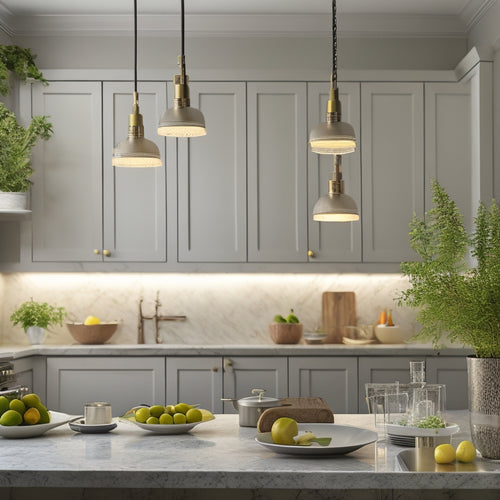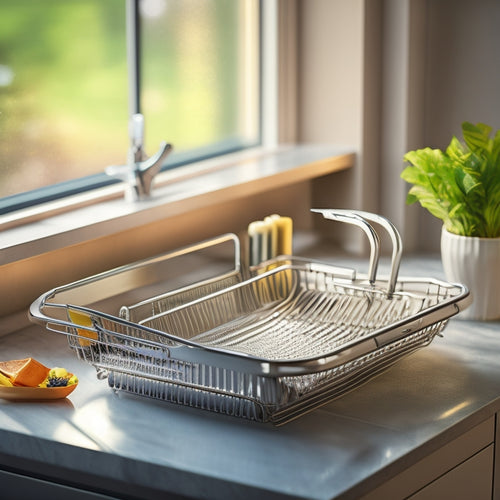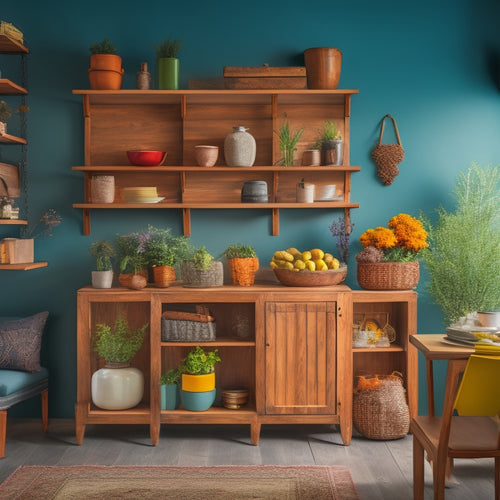
What Defines a Truly Minimalist Kitchen Space?
Share
You'll know a truly minimalist kitchen space when you see one: it's a carefully curated blend of sleek surfaces, clever storage solutions, and a thoughtful selection of appliances, all working together to create a visually appealing and highly functional space that exudes sophistication and calmness. By intentionally editing features, incorporating clever storage, and creating a harmonious color scheme, you'll create a space that's both beautiful and efficient. As you explore the world of minimalist kitchens, you'll uncover more strategies to refine your design and elevate your cooking experience.
Key Takeaways
• A truly minimalist kitchen space is defined by intentional editing of features, eliminating clutter and excess.
• Sleek countertops and clever storage solutions create a sense of openness and visual appeal.
• A curated selection of appliances and utensils reduces visual noise and increases functionality.
• A simple color scheme, often featuring neutral tones, provides a clean backdrop for the space.
• Embracing negative space and avoiding clutter creates a sense of breathability and efficiency in the kitchen.
Essential Features of Minimalist Kitchens
You'll find that a hallmark of minimalist kitchens is the intentional editing of features, leaving only the essentials that serve a clear purpose, such as sleek countertops, clever storage solutions, and a curated selection of appliances. This thoughtful approach creates a space that's both visually appealing and highly functional.
A well-designed functional layout is essential, allowing you to move seamlessly between cooking, preparing, and serving. By allocating specific areas for each task, you'll create a sense of harmony and flow.
High-quality appliances, such as a sleek refrigerator or a professional-grade stove, not only enhance the aesthetic but also provide superior performance. These carefully chosen elements work together to create an environment that's both beautiful and efficient.
As you design your minimalist kitchen, remember that every element should serve a purpose, and every detail should contribute to a sense of serenity and sophistication. By doing so, you'll create a space that's perfect for serving others, whether it's a casual breakfast or a formal dinner party.
Decluttering Strategies for Kitchen Spaces
By incorporating strategic decluttering techniques, such as the 'one in, one out' rule and designated zones for frequently used items, you can create a kitchen space that exudes a sense of calm and visual appeal.
To take your decluttering efforts to the next level, consider the following strategies:
| Decluttering Task | Tips and Tricks |
|---|---|
| Organizing Utensils | Store frequently used utensils in easy-to-reach locations, such as a utensil organizer near the cooking station. |
| Decluttering Countertops | Designate a specific area for countertops, like a "launching pad" for daily essentials, and keep it tidy. |
| Purging Kitchen Gadgets | Be honest about which gadgets you truly use and donate or discard the rest. |
| Streamlining Storage | Use vertical storage options, like shelves or hooks, to maximize space and keep items off the countertops. |
Simple Color Schemes for Kitchens
A calming color palette can effortlessly transform your kitchen into a serene retreat, where cooking and socializing blend seamlessly together. By choosing a simple color scheme, you'll create a harmonious atmosphere that invites conversation and connection. Neutral tones, such as soft grays, creamy whites, and warm beiges, provide a clean backdrop for your kitchen design. These calming hues won't compete with the vibrant colors of fresh ingredients or the rich tones of cooking utensils.
To take your kitchen's color scheme to the next level, consider a monochromatic palette. This design approach involves selecting different shades of a single color to create a cohesive look. For example, various shades of blue, from sky blue to navy, can evoke a sense of calmness and serenity.
Streamlined Kitchen Storage Solutions
Optimize your kitchen's functionality with clever storage solutions that keep countertops clear and essentials within easy reach, freeing you to focus on cooking up a storm. By incorporating hidden compartments and sleek shelving, you'll create a sense of calm and clarity in your kitchen.
Imagine having all your utensils, spices, and cookware neatly tucked away, yet easily accessible when you need them.
Multi-functional furniture is another key element in achieving a streamlined kitchen. Consider investing in a kitchen island with built-in storage or a wall-mounted pot rack that doubles as a utensil holder.
These space-saving techniques will help you make the most of your kitchen's real estate, creating a sense of flow and efficiency. By keeping frequently used items within easy reach, you'll be able to serve up delicious meals with ease and confidence.
With a well-designed kitchen storage system, you'll be free to focus on what matters most – sharing meals and making memories with loved ones.
Embracing Negative Space in Design
You'll find that strategically leaving some areas of your kitchen unfurnished or unadorned creates a sense of breathability, allowing the eye to rest and the mind to focus on the beauty of functional simplicity. This concept, known as negative space, is a fundamental design principle that can elevate your kitchen's aesthetic and functionality.
By embracing negative space, you'll create a sense of calm and serenity, making your kitchen a more enjoyable space to cook, entertain, and socialize.
Here are a few ways to incorporate negative space into your kitchen design:
-
Leave some walls bare: Avoid cluttering every inch of wall space with cabinets, shelves, or decor. Instead, leave some areas open to create a sense of visual balance.
-
Choose multi-functional pieces: Select furniture and appliances that serve multiple purposes, reducing the need for additional items and promoting a sense of minimalism.
-
Edit your decor: Resist the urge to over-accessorize. Instead, choose a few statement pieces that add visual interest without overwhelming the space.
Frequently Asked Questions
Can a Minimalist Kitchen Still Have Decorative Elements?
"Don't you think a kitchen can be both beautiful and functional? You can strike a balance between minimalist and cozy by incorporating decorative elements that serve a purpose, prioritizing functionality over aesthetics, and embracing simplicity."
Do Minimalist Kitchens Have to Be Small in Size?
You don't need a tiny kitchen to achieve minimalism; focus on space utilization and functional simplicity. By optimizing every inch, you can create a sleek, efficient space that serves others beautifully, regardless of its size.
Can I Still Have a Kitchen Island in a Minimalist Design?
You don't have to sacrifice function for form; instead, consider island alternatives like a cart or peninsula, and prioritize storage solutions that showcase functional simplicity and streamlined aesthetics, all while maintaining a sense of elegance.
Are Minimalist Kitchens Only for Modern-Style Homes?
You don't have to live in a modern-style home to create a minimalist kitchen; traditional homes can also incorporate clean lines, retro aesthetics, and functional simplicity, allowing you to serve others in a space that's both elegant and efficient.
Can I Mix High-Tech and Minimalist Design Elements Together?
You'll be surprised to know that 70% of homeowners prioritize functionality over aesthetics. You can definitely mix high-tech and minimalist design elements, balancing simplicity with functionality, by incorporating sleek high-tech appliances that blend seamlessly into your minimalist aesthetic.
Related Posts
-

Tips for Choosing Under-Cabinet Lighting Fixtures
When choosing under-cabinet lighting fixtures, consider your kitchen's layout and functionality. Assess countertop ma...
-

Rust-Resistant Dish Drainers for Long-Lasting Use
If you're looking for rust-resistant dish drainers, focus on materials like high-grade stainless steel for superior c...
-

Creative Corner Cabinet Space Management
Creative corner cabinet space management turns neglected nooks into stunning storage solutions. You can maximize vert...


